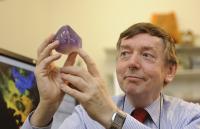
This is Dr. Brad Amos, Visiting Scientist, University of Strathclyde. A new form of microscope which can produce results in seconds rather than hours – dramatically speeding up the process of drug development - is being developed by researchers at the University of Strathclyde in Glasgow, Scotland.
Scientists are creating a lens which will be capable of showing three-dimensional images within cells and tissues at the same time as showing the whole organism, something which is currently not possible with any single imaging device.
The innovative Mesolens – the only device of its kind in the world - will be able to capture detail in organisms which are too big to be examined satisfactorily by existing microscopes and will offer a deeper insight into areas such as cancerous tissues and the cortex of the brain.
Dr Brad Amos, a Visiting Scientist at the Strathclyde Institute of Pharmacy and Biomedical Sciences, will discuss the device at the prestigious Leewenhoek Lecture, which is given every three years and recognises excellence in the life sciences, at the Royal Society in London on Monday, 13 February. __IMAGE_2
Dr Amos, who is also Emeritus Research Group Leader in the Medical Research Council (MRC) Laboratory of Molecular Biology and a Fellow of the Royal Society, said: "The global health challenges of the 21st century demand new and powerful treatments but the process of drug discovery and delivery is often time-consuming and costly.
"The information provided by microscopes is vital to this process but can take hours at a time to emerge. The confocal lens can be trained simultaneously on or inside an individual cell and the full organism, with strong resolution and will have the capacity to deliver 3D images which go far beyond the limitations of 2D representations. __IMAGE_3
"This level of detail can open up vast possibilities for discoveries which can contribute to the fight against disease worldwide."
Dr Gail McConnell, a Reader at the Strathclyde Institute of Pharmacy and Biomedical Sciences, is a partner in the research. She said: "Our research fits with Strathclyde's ethos of technical innovation with universal impact. We already have the two-dimensional technology for the lens in place, but a third dimension will allow us to take the revolutionary step of presenting images with a range and versatility which no single imaging platform can currently offer." Source : University of Strathclyde
 Print Article
Print Article Mail to a Friend
Mail to a Friend
